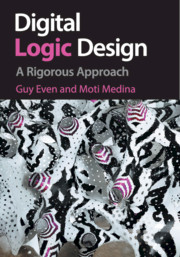17 - Flip-Flops
from PART III - SYNCHRONOUS CIRCUITS
Published online by Cambridge University Press: 05 November 2012
Summary
So far we have focused only on combinational circuits. It is time to deal with circuits that have a memory. Memory, in principle, means that the output depends not only on the input but also on the history. However, if we wish to refer to the history, then we need a notion of time. So before we consider a memory device, we must address the issue of time.
Time in digital logic is defined by a special signal called the clock. The clock signal is not a clock in everyday terms; it is simply a periodic signal that alternates between zero and one. The alternations help us partition time into disjoint intervals, called clock cycles.
Bits are stored in a special memory device called a flip-flop. The definition of flipflops is rather elaborate and requires that the input be stable during a critical segment. One may wonder why such a complicated definition is required. We prove that flip-flops with empty critical segments do not exist.
THE CLOCK
Synchronous circuits depend on a special signal called the clock. In practice, the clock is generated by rectifying and amplifying a signal generated by special nondigital devices (e.g., crystal oscillators). Since our course is about digital circuits, we use the following abstraction to describe the clock.
Definition 17.1 A clock is a periodic logical signal that oscillates instantaneously between logical one and logical zero.
- Type
- Chapter
- Information
- Digital Logic DesignA Rigorous Approach, pp. 247 - 263Publisher: Cambridge University PressPrint publication year: 2012

